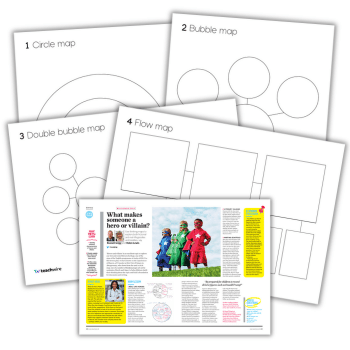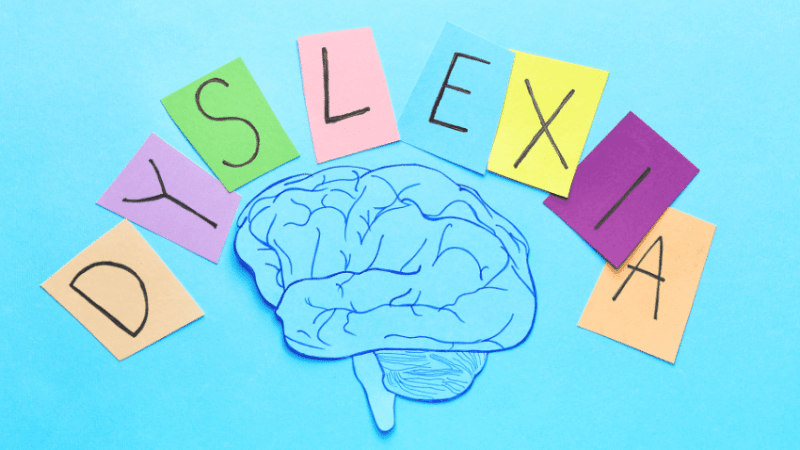ADHD Awareness Month – 2025 UK education resources

Get ready to embrace ADHD Awareness Month by exploring these practical resources and techniques to better understand and support students with ADHD in your classroom…

- by Teachwire

With ADHD Awareness Month around the corner, discover valuable resources and strategies to create an inclusive learning environment for all your students…
Table of contents
What is ADHD Awareness Month?
ADHD Awareness Month’s goal is to provide reliable information and resources to help people thrive with ADHD.
When is ADHD Awareness Month?
ADHD Awareness Month is in October.
What is the theme for 2025?
The theme for this year’s ADHD Awareness Month is ‘The Many Faces of ADHD’.
How to celebrate ADHD Awareness Month in school
Join a teacher group
ADHD UK’s Teachers & Workers in Education group meets to discuss strategies for working with pupils with ADHD. There are also virtual forums and opportunities to participate in important ADHD research.
Class novel

The Boy with the Butterfly Mind by Victoria Williamson is an affecting story about two children – one with ADHD – thrown together into a blended family. It’s engagingly written in short chapters and is a great way to explore difference, empathy, behaviour, mental health and more.
Download a resource pack from Seven Stories which contains ideas for sharing the story and related cross-curricular activities. You can also download a Kindness Butterflies poster with space for children to add words and pictures.
Discover more books featuring characters with ADHD in this list from BookTrust.
Celebrate the natural advantages of ADHD
ADHD and associated difficulties in school can often impact a child’s self-esteem. However, children with ADHD possess some common attributes that may give them advantages in certain areas. ADHD Awareness Month is a great time to reflect and promote these attributes:
- A different perspective that lends itself well to innovative and imaginative thinking
- The ability to rise to a challenge if given responsibility
- A keen sense of justice and fairness
- A strong passion and aptitude for topics, sports or hobbies that they find interesting
A large number of successful public figures have been diagnosed with ADHD – many of them unusual thinkers who possess great drive and energy.
Concentrate on children’s strengths

As teachers, we can influence how the ADHD label is perceived by focusing attention on children’s strengths. One way of doing this in the classroom is to write every child’s name on a piece of paper and hand them out to the class.
Ask everyone to think of the nicest thing they can say about the person on their paper and have them write a compliment – something they’re good at, an admirable personality trait or anything praiseworthy that they’ve done.
Everyone then passes their paper on and writes a compliment for the next name they’re given, continuing until everyone’s written one nice thing about each child in the class.
Collect the papers in, type the comments up and then present every child with their own personal list of positive labels. What if, instead of ‘ADHD’ or ‘difficult’, a child might be able to wear the labels ‘clever’, ‘good at science’, ‘keen singer’ or ‘sporty’?
Labels matter, so let’s help children lose those that describe behaviours often outside their control and find ones that describe who they really are.
Victoria Williamson is a primary school teacher with a Master’s degree in special needs education. Her second novel, The Boy with the Butterfly Mind is available now, published by Floris Books.
What is ADHD?
Attention Deficit Hyperactivity Disorder (ADHD) is a medical disorder involving brain chemistry. It affects the front part of the brain which controls our ability to think rationally, learn from experience and control impulsive behaviour.
Children with ADHD have fewer chemical transmitters in this area than normal, resulting in spontaneity, risk-taking and lack of concentration.
ADHD affects around 2 to 5% of school-aged children and young people in the UK. The condition has no impact on a child’s overall intelligence, but it can impair their progress unless carefully controlled.
Children with ADHD find studying and concentrating a real struggle. Many fall behind in class, and their initial enthusiasm and fervour can quickly turn to disillusionment, depression and a sense of failure.
“ADHD affects around 2 to 5% of school-aged children and young people in the UK”
The earlier the condition is picked up and diagnosed, the sooner children can receive appropriate treatment and learn to control their symptoms – and thus begin to succeed and flourish.
ADHD cannot be ‘cured’, but it can respond to behavioural therapy, medicine and lifestyle changes.
What teachers need to know about ADHD
- There is a lot more to ADHD than hyperactivity. In fact, there are three ‘presentations’ of ADHD: hyperactive-impulsive, inattentive and combined type. The most common form in the general population is actually inattentive, not hyperactive-impulsive.
- ADHD is regarded as a ‘neurodevelopmental disorder’, which puts it in the same category as autism spectrum disorder (ASD). However, ADHD is more than twice as common as ASD.
- ADHD has historically been underdiagnosed in women and minority groups. When you look at population-based studies, for every one girl with ADHD, there are two boys. But when you look at clinical referrals, the ratio is double that (one girl to four boys).
Dr Mark Kennedy is senior teaching fellow at The Institute of Psychology, Psychiatry and Neuroscience, King’s College London, and lead educator on the Understanding ADHD: Current Research and Practice course on the FutureLearn Platform.
Spotting students with ADHD

There are three behavioural indicators to look out for – inattention, impulsiveness and hyperactivity, though some children will not exhibit all three.
Inattention
This is more common among girls.
- Easily distracted, lacks focus
- May not listen properly
- Makes careless mistakes
- Poor short-term memory
- Experiences difficulty in following instructions
- Appears detached and/or absent-minded
- Will often lose things, arrive late, become lost or forget things
- Will avoid tasks requiring sustained mental effort
Impulsiveness
- Shouts out in class
- Impatient
- Excitable
- Finds it difficult to wait their turn, will frequently interrupt
- Often agitated
- Reacts emotionally, rather than rationally
- Can become angry and aggressive, will frequently argue with peers
- Keen to take risks taker, likes excitement
Hyperactivity
This is more common among boys.
- Fidgets and jiggles when sitting, appears restless and distracted
- Frequently leaves seat in class
- Tendency towards being silly and showing off
- Fondness for running or climbing at inappropriate times
- Excessive talking
- Chaotic manner; will often arrive late without correct equipment
The case for earlier ADHD interventions

Sarah Templeton, managing director of Headstuff ADHD Therapy and CEO of ADHD Liberty, argues that early identification and support for ADHD can prevent exclusions and reduce the school-to-prison pipeline…
Having worked in the British criminal justice system with young offenders, I can tell you that the school-to-prison pipeline is real.
Almost every young offender I’ve worked with left school early, and almost all had undiagnosed ADHD, dyslexia, dysgraphia, dyscalculia, autism or some combination of these.
This isn’t a complex mystery needing endless research and funding, though. The solution is right in front of us, in that it all starts back in the classroom.
Let’s start with the behaviours that often lead to exclusion:
- disrupting lessons
- talking too much
- interrupting the teacher
- shouting out
- restlessness
- fiddling/doodling
- struggles to sit still
- prone to distraction
- difficulties in staying focused
Every one of those is a trait of ADHD.
Now, consider the child who struggles with writing and spelling, or who performs well in every subject except maths. Or the child who seems lost in daydreams, rather than causing disruption.
These can all be signs of dyslexia, dysgraphia and dyscalculia or of ADHD Inattentive type – far less visible, but just as significant.
Identifying ADHD doesn’t need to be complicated. Use free ADHD screeners, available online or in print form, at the start of each school year, enabling ADHD to be medicated or managed sooner.
You may also identify coexisting learning difficulties and can then put support in place for lessons and exams. This way, pupils feel included, not excluded.
The change in self-esteem when a child realises they aren’t a failure, but simply learn differently is transformative. That confidence is what keeps them in school, engaged and ultimately out of the criminal justice system.
Imagine a system where school exclusion doesn’t exist, because every child’s needs are recognised and met. It’s possible, if we equip teachers with the right tools.
Sarah Templeton’s memoir, The Prison Counsellor: Her Only Crime Was Caring, is available now (Gemini Publishing).
How to help a child with ADHD

Children with ADHD can be both challenging and extremely rewarding to teach. You may find the following helpful when supporting a child with ADHD in class…
Support
If the 2013 Blatchford report taught us anything, it’s that annexing off an individual pupil with support staff will likely have an adverse effect on their social and academic attainment.
No one’s denying that some pupils will require one-to-one support to engage in learning, but simply sitting the ADHD pupil beside a TA in order to minimise disruption could do more harm than good.
Why is that? The answer involves considering the wide range of social factors that soon come into play, due to the disrupted social and emotional development experienced by children with ADHD. Significantly, pupils with ADHD are far more likely to develop an atypical attachment style than their peers.
With that in mind, think about how sitting that child next to an adult and cutting them off from the perceived safety of their peer group might affect their engagement.
Visual learning aids
Use visual learning aids, including gestural language, as part of the lesson, in addition to resources specifically crafted as behaviour strategies.
Visual behaviour charts with a small number of individual targets, sand timers and visual ‘now and next’ boards can be used to keep pupils with ADHD on task for increasing amounts of time by offering rewards for meeting certain criteria. You’ll want to keep these learning tasks short to begin with, before extending them across the year.
Clarity and classroom rules
Establish clear school rules, and remind the children of these periodically. Start every lesson the same way each time, as this gives security.
Your demeanour should be positive, upbeat, firm but approachable. Try to develop a signal that the child can recognise if they are misbehaving, or a way for them to alert you if they are feeling particularly agitated or upset.
Seating
For children with ADHD, sitting in traditional rows will often work better than sitting around tables facing their peers. Sit the child at the end of the row, away from windows, noisy pipes, doors, class pets and other distractions. Ensure that you can maintain easy eye contact with them throughout the lesson.
Find a space in the room that doesn’t offer the pupil an audience (perhaps near the front or to one side, where other pupils won’t be facing them) and sit them near to pupils who offer positive role-modelling.
The child may further benefit from being seated in an area that other pupils won’t need to walk through during the lesson, thus limiting distractions and opportunities for them to draw reactions from their peers.
Discipline
Put in place clear and fair rules on discipline, ensure that these are observed consistently and reward and reinforce good behaviour. Outline exactly what behaviour is unacceptable, and explain the consequences of misdemeanours; give clear warnings of any unacceptable behaviour.
Punishments should be fair and feasible to carry out. If poor behaviour is repeated, act decisively and firmly, but do not shout or lose your temper. Don’t take any outbursts personally.
Keep the phrase ‘consequences without conflict’ in mind. The child needs to know that any disruptions to a lesson won’t be tolerated, and that as such, there’ll be consequences. These consequences, however, shouldn’t involve the pupil being challenged.
“Keep the phrase ‘consequences without conflict’ in mind”
After all, you could be dealing with an attachment issue and/or a child who perceives any challenge, academic or otherwise, as a direct threat to their emotional or physical wellbeing.
Try the ‘triple-tell approach’.
- Explicitly point at a written rule
- Get all students to look at the rule
- Read out the rule in full: ‘Red means no talking’
The triple-tell approach gives three routes into the brain, and so amplifies the message.
Descriptive praise
All students need praise, but students with ADHD need it even more – not least because they’re less likely to get it. Praise their effort, progress and approach (how they did something).
Lessons
Keep your lessons fast-paced and innovative, with frequent changes of activity. Employ a multisensory approach by using visual aids, film clips, audio and materials that the pupils can handle.
Include practical exercises: use coloured pens, mini whiteboards, make posters or games. Allow children to act and write poems or songs.
You can also try silent working, think pair share, group work, cooperative learning, card sorts, quickfire quizzes, hot seating and project-based work. Shift between these and other approaches to keep learners engaged.
Break work down into meaningful blocks of learning with short-term goals. This allows for mini mental breaks, gives you an opportunity to check for understanding and makes the work seem less daunting.
Movement
Factor in time for movement in the form of a practical exercise. You can also let children with ADHD give out materials, collect books, open windows and perform other tasks – provide them with opportunities to be helpful.
If possible, try setting aside an area of the room with different seating – bean bags or rugs, for instance – that children can move to.
Computers
These are often popular with ADHD children, since they can be stimulating and fun while providing instant, non-judgemental feedback. In addition to using ICT to present their work, time on the computer can be used as a reward.
Homework
Don’t expect too much. Try to make it innovative and fun, and mark for content and effort – not presentation. Enlist the help of family to create a set of home-based routines to get the work done.
Responsibility
If possible, give children with ADHD a role in the class or school. Show that they are trusted and that you have high expectations of them. Celebrate their successes where appropriate, and remember to report the good things they do, as well as any problems.
Routines
Students with ADHD benefit greatly from routines. The ‘you tell me’ approach helps. Instead of reminding a student of what any given routine entailed, get them to remind you about the what, the when and the how. Turn it into a bit of a game, seeing how much they can remember.
Your attitude
It is important to remain calm in your dealings with children with ADHD – be firm, but approachable. Remember to smile and show them that you care – it will make a huge difference.
Try and depersonalise the behaviour. Try repeating this mental mantra in order to stay emotionally neutral: “This is their ADHD”.
Persistence gets you to where you want to go. It also gives students with ADHD an important message – you believe in them and they are worth persisting with.
If you believe that your teacher believes those things about you, then ADHD or no ADHD, you will make progress.
Thanks to Diana Hudson, Dane Norris and Robin Launder for these tips. Diana is the author of Specific Learning Difficulties – What Teachers Need to Know (Jessica Kingsley Publishers, £12.99). Dane is a primary teacher specialising in SEN. Robin Launder is the director of Behaviour Buddy – a company specialising in evidence-based CPD – and serves on the executive committee of PRUsAP, which represents PRUs and the alternative provision sector. For more information, visit behaviourbuddy.co.uk or follow @behaviourbuddy.










